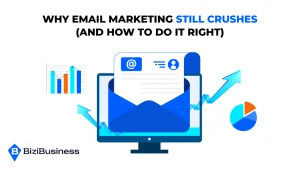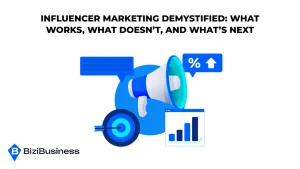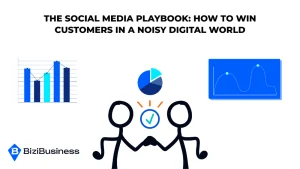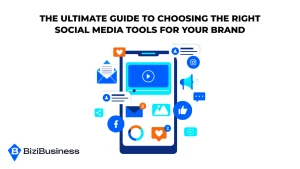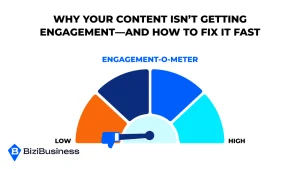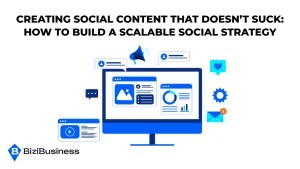BiziTopics
The Smart Marketer’s Playbook For Email Campaign Success
BiziBusiness
Aug 12, 2025
10 min read
Despite what the skeptics say, email is still one of the most profitable marketing channels — delivering up to $42 in ROI for every $1 spent. If your emails aren’t converting, the problem isn’t email. It’s execution.
Most marketers rely on outdated tactics: blasting generic messages, clickbait subject lines, and zero personalization. That doesn’t work anymore.
Today’s audiences expect relevance, value, and timing. If your message doesn’t deliver, it gets ignored or deleted.
The good news? With the right strategy, email design can become your most reliable and scalable revenue driver.
WARNING: Most Email Advice Is Holding You Back

If you’ve heard that sending more emails means making more money, it’s time to unlearn that advice. “More sends = more sales” is a myth that’s tanking open rates and killing deliverability.
Here’s the truth: inboxes are smarter, and so are subscribers. Flooding your list with high-frequency, low-value messages only trains people to ignore you. Or worse, mark you as spam.
The real reasons most campaigns flop have nothing to do with how often you hit “send.” It’s about what you’re sending, who you’re sending it to, and what you’re asking them to do.
- Low-value content means messages that talk about you, not what the reader actually cares about.
- Poor segmentation sends irrelevant offers to the wrong people, like pitching a “welcome offer” to long-time customers.
- Unclear CTAs leave readers wondering what to do next, so they do nothing at all.
And every time that happens, you lose more than a click. You lose trust.
Bad email strategy and the wrong tools and platforms don’t just underperform—they actively damage your brand, your domain’s reputation, and your future chances of reaching the inbox.
Smart marketers don’t send more. They send smarter.
The Rules Have Changed: Email Has Evolved
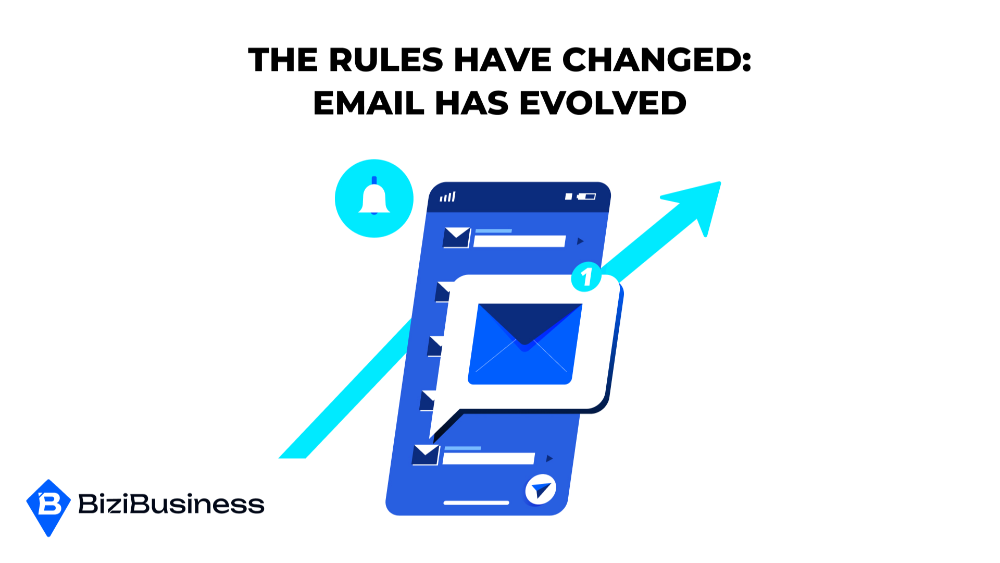
Email marketing used to be simple: write a newsletter, blast it to your entire list building, and wait for clicks. That might’ve worked in 2010—but in today’s inbox? It’s a guaranteed way to get ignored.
The inbox is no longer a passive space. It’s a highly filtered, behavior-sensitive environment where only the most relevant and well-timed messages win.
From Mass Messaging to Micro-Moments
Modern email marketing is about personalization at scale. That means understanding user behavior—what they click, browse, or ignore—and using that data to trigger campaigns that feel like they were written just for them.
Think less “newsletter to all” and more:
- A cart reminder sent 30 minutes after abandonment
- A special offer for a loyal customer based on past purchases
- A re-engagement sequence when someone ghosts your emails for 30+ days
These aren’t just clever tactics—they’re the new standard.
Relevance Is the Currency of Attention
Consumers today are overexposed and underwhelmed. If your email isn’t timely, valuable, and personalized, it’s just noise.
- Relevance ensures your email makes it past the mental filter
- Timing increases the chance it’s opened and read
- Value earns clicks, trust, and long-term engagement
Anything less, and your message disappears into the digital void.
Adapt or Get Ignored
Email filters are smarter. Audiences are savvier. And attention spans are shorter than ever. If your strategy hasn’t evolved, you’re not just behind—you’re invisible.
To stand out, you must match content to context. Use automation & workflows, behavior tracking, and segmentation to make your emails feel like helpful nudges, not intrusive sales pitches.
It’s not about sending more. It’s about sending what matters—to the right person, at the right time, with the right message.
The Anatomy Of A Smart Email Campaign

Smart email campaigns aren’t built on guesswork — they’re crafted with intention, precision, and strategic flow. Every element matters, and when each piece works together, the results speak for themselves.
Here’s what separates a high-performing campaign from a forgettable one:
Start With Strategy
Before you write a single word, get clear on your goal.
- Are you driving traffic?
- Promoting a product?
- Nurturing a lead?
- Onboarding a new user?
Without a defined objective, your message drifts — and so does your reader. Strategy aligns everything: the copy, design, segmentation, and CTA.
Segment Smart
One message won’t work for everyone. Your subscribers are at different stages, with different needs. Smart segmentation ensures you’re speaking to the right person, with the right message, at the right time.
Break down your audience by:
- Behavior (clicks, purchases, site visits)
- Lifecycle stage (new lead, customer, churned user)
- Demographics or interests
A segmented email is 4X more likely to generate engagement. Ignore this step and you risk being irrelevant.
Craft Killer Subject Lines
The subject line is the gatekeeper — if it doesn’t earn the click, nothing inside matters.
Smart subject lines are:
- Clear over clever
- Benefit-focused (“Get 20% More Leads in 7 Days”)
- Curiosity-driven without being clickbait
- Short and sharp (40–50 characters max)
Don’t forget the preview text — it’s your backup hook.
Copy That Connects
Once they open, you have seconds to hook them. Your copy needs to:
- Speak directly to the reader’s problem or desire
- Use conversational, benefit-led language
- Follow a structure: Hook → Value → CTA
Inject personality. Use storytelling. Leverage psychology — like urgency, scarcity, or social proof — to guide action. But above all, be clear, not clever.
CTAs That Convert
Your call-to-action is the tipping point. Make it count.
- Focus on one clear CTA — multiple links confuse and dilute action
- Use action-oriented language: “Get My Free Guide,” “Try It Now”
- Ensure it visually stands out and appears at least twice
A smart CTA aligns with your strategy and gives readers a reason to click now.
From Strategy To Send: Building Your First High-ROI Campaign
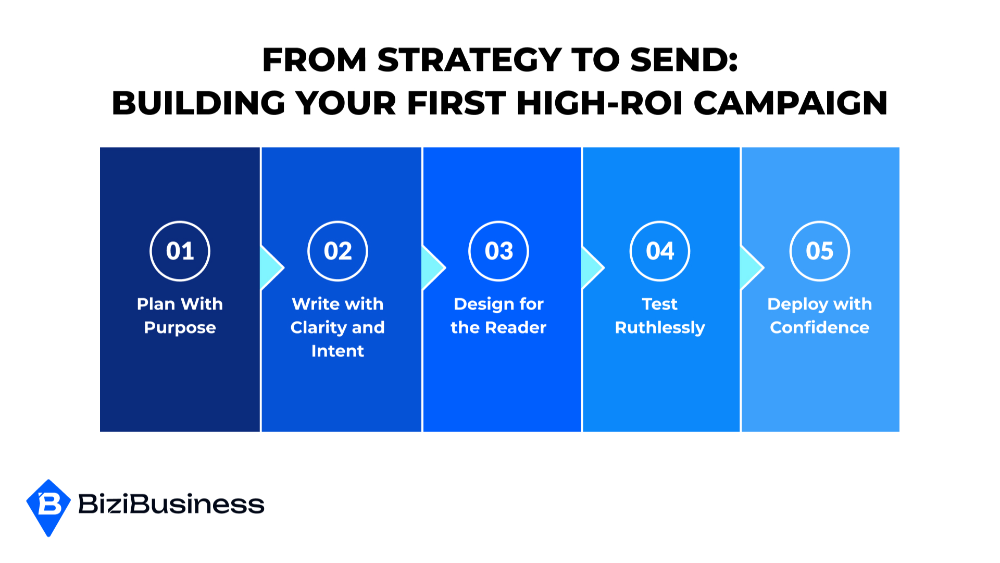
Creating a high-performing email campaign doesn’t start with writing—it starts with stategy and planning. Every stage from concept to click needs purpose and precision. Here’s a step-by-step framework to build an email campaign that delivers results, not just noise.
Step 1: Plan With Purpose
Before you touch the keyboard, clarify the goal of the campaign. Are you aiming to:
- Drive traffic to a product page?
- Recover abandoned carts?
- Re-engage inactive subscribers?
- Educate and nurture leads?
Define your audience, message, and offer clearly—this forms the foundation of everything that follows.
Step 2: Write with Clarity and Intent
Use everything you outlined in planning to guide your copy. Focus on:
- A strong subject line and preview text
- A compelling hook in the first sentence
- Clear benefits—not features
- One focused CTA (and repeat it)
Every word should earn its place. If it doesn’t drive engagement or action, cut it.
Step 3: Design for the Reader
Your design should support—not distract from—your message. Stick to:
- Mobile-friendly, single-column layouts
- Clear visual hierarchy (headlines, bullets, CTA)
- Limited images to avoid slow load times
Make sure your email looks clean, not cluttered. Function wins over flash.
Step 4: Test Ruthlessly
Testing separates the amateurs from the pros. Before you hit send:
- Test across devices and browsers
- Preview both dark mode and light mode
- Check for broken links and load time
Also, A/B test subject lines, CTA language, and send times to improve over time.
Step 5: Deploy with Confidence
Use your ESP’s tools to:
- Schedule based on time zone or user behavior
- Suppress unengaged segments
- Monitor for soft bounces or spam flags
Make sure your campaign is going to the right people, at the right time, with the right content.
Avoid These Common Mistakes
Even great campaigns get tripped up by simple errors. Watch out for:
- Broken links or incorrect URLs
- Overloaded HTML from drag-and-drop editors
- Missing alt text on images
- Forgotten preview text or fallback fonts
Your Pre-Send Checklist
Before every send, ask:
- Is the goal clear and trackable?
- Is the list properly segmented?
- Does the subject line promise value?
- Is the email mobile-optimized?
- Is there only one clear CTA?
By using smart cross-channel integration, you’re not just sending an email—you’re launching a high-ROI asset.
Optimize Or Die: Continuous Improvement Is The Name Of The Game

Even the best-crafted email isn’t a “set it and forget it” asset. If you’re not analytics and metrics every send, you’re leaving performance—and revenue—on the table.
Email marketing is a game of iteration. What worked last month may flop today. Optimization isn’t optional—it’s survival.
Metrics That Matter
Too many marketers obsess over open rates. But opens are just the start. The real insights come from:
- Click-through rate (CTR): Shows if your message and CTA resonated
- Conversion rate: Measures how many readers took the intended action
- Bounce rate: Flags list quality and deliverability issues
- Unsubscribe rate: Reveals if your content or frequency is missing the mark
Track these consistently. Know your benchmarks. Watch for trends and drops that signal it’s time to adjust.
How to Test Smarter
Testing isn’t just for subject lines. To truly optimize performance, experiment with:
- Subject line styles: urgency, curiosity, personalization
- Body copy tone and structure: short vs. long, story vs. bullet points
- Timing: day of week, time of day, user time zones
- CTA placement and language
Only test one variable at a time, and give it enough volume to gather meaningful results. The goal isn’t random tweaks—it’s data-backed decisions.
Build Feedback Loops
Your email list talks—you just have to listen. Look at what they click, what they ignore, when they unsubscribe, and what they forward. That’s your roadmap.
Set up a feedback loop:
- Monitor results consistently
- Apply learnings to future campaigns
- Adjust based on user behavior, not gut feelings
Over time, this cycle of testing and optimization, learning, and refining turns a good email program into a scalable growth engine.
How To Build A Sustainable Email Engine

Success with email isn’t about sending more. It’s about sending smart—and doing it consistently.
Short bursts of activity followed by silence confuse subscribers and kill momentum. But a steady rhythm of high-value emails builds trust, primes your audience, and keeps your brand top of mind.
Why Consistency Beats Frequency
Blasting emails daily might spike short-term clicks, but it burns out your list fast. On the other hand, disappearing for weeks trains subscribers to forget you exist.
Consistency sets expectations. Whether it’s once a week or twice a month, the goal is regular, reliable value. That’s how you build loyalty and long-term engagement.
Create a Strategic Email Calendar
Random sends equal random results. Smart marketers operate with a purpose-built calendar that aligns email campaigns with broader marketing initiatives—like product launches, seasonal offers, or content themes.
A good calendar:
- Plots out campaigns weeks (or months) in advance
- Balances promotional and value-driven content
- Segments messages for different stages of the customer journey
It gives structure to your strategy—and prevents last-minute, low-impact sends.
Make Email a Core Growth Pillar
Email isn’t just a side channel—it’s a high-leverage asset. Use it to:
- Educate leads before the sales team steps in
- Reactivate dormant users with targeted offers
- Convert new subscribers into loyal customers
- Support retention with post-purchase nurture flows
When email is integrated into your marketing ecosystem—not treated as an afterthought—it becomes a flywheel for sustained growth.
Ready To Win the Inbox War? Here’s Your Next Move
Let’s recap the mindset shift:
- Email isn’t outdated—bad execution is.
- Blasting your entire list won’t work—smart segmentation and personalization will.
- Opens aren’t enough—clicks and conversions are what count.
- Great campaigns aren’t guessed—they’re planned, tested, and optimized.
You now have the blueprint to create campaigns that engage, convert, and grow your business. The only thing left is action.
So, here’s your next move:
- If you’ve never launched a strategic campaign: Start with a single, goal-driven email. One offer. One CTA. One target segment.
- If you’re already sending emails: Audit your last three campaigns. What worked? What didn’t? Where can you apply smarter segmentation or tighter messaging?
Stop guessing. Start growing.
Subscribe to Newsletter
Unlock your creativity and stay up to date on marketing tips
